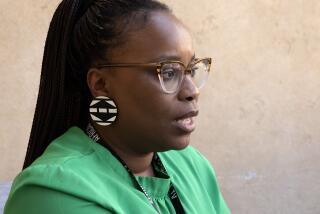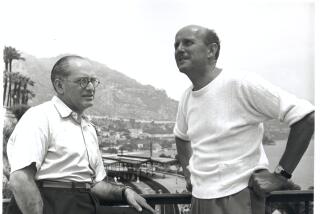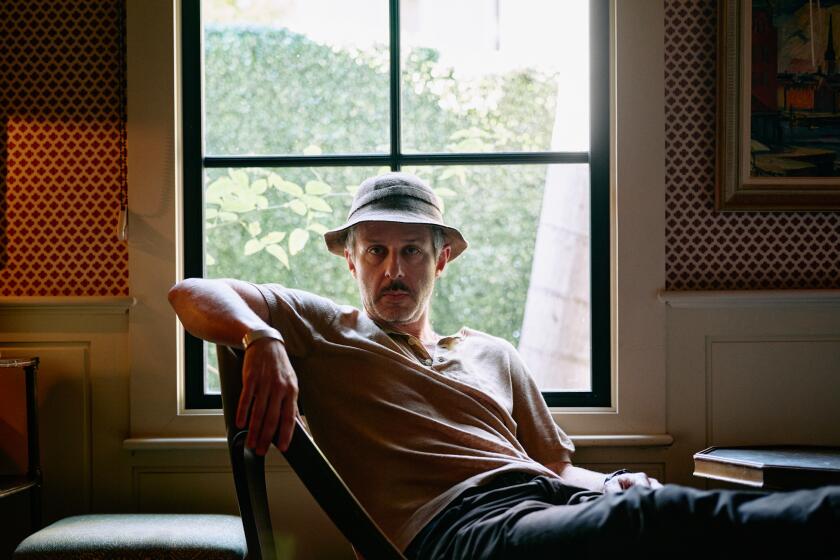The Proof Will Be in the ‘Europudding’
PARIS — For years, European cultural authorities have wrestled with ways to stem the tide of Hollywood films and TV programs washing up on European shores, and nowhere is the dam-building effort more dramatic than in France. To counteract U.S. cultural imperialism, the French have clamped content quotas on broadcasters, created special programs to support the local talent and even taxed box-office receipts to gin up money for deserving filmmakers.
But Hollywood’s big-budget action films, superstars and spectacular effects keep coming, and in recent years it’s become fashionable to wonder if French filmmakers have collapsed from ennui.
It turns out they haven’t gone underground--they’re taking lessons in how to leverage. Producers, whether they’re handling schlock or high art, are devising new ways to tap into money and distribution networks in more than one European country, frequently by bending projects to fit rigorous funding requirements. Forget that quintessential French concept, “l’auteur,” and stand back for the New Wave “coproducteurs.”
Coproduction isn’t new. The ‘80s gave rise to big, unwieldy coproductions that were so bad some critics called them “Europuddings.” What’s new is the emphasis on creative control and increased know-how about fusing funds from more than one source.
“Because filmmaking is so expensive, nearly all European films have multi-source financing,” said Paris-based entertainment lawyer Daniel Walker, who is helping to piece together nearly a dozen coproductions this year. And for coproducers with the patience to meet various requirements, there are national and international funds available for projects involving more than two countries.
In contrast, major studio films in Hollywood are privately financed and tend to be driven almost exclusively by market demand. This can be brutal to artistic vision, but some critics contend that European films are less competitive in the marketplace because they have to satisfy bureaucratic agendas for funding.
“With all those masters to please, some coproducers risk losing sight of the film,” Walker conceded. “But not if the lead producer can juggle the financing with one hand while making the film with the other.”
He pointed to last year’s critical hit “Breaking the Waves,” whose director was Danish but whose funding flowed from more than 20 sources in five countries. “It could have been the ultimate Europudding,” Walker said, “but producers are getting more savvy.”
The process of coproduction financing can be immensely cumbersome. The paperwork for French coproductions flows through the notoriously protectionist film authority, le Centre National de la Cinematographie.
CNC spokeswoman Catherine Merlhiot said the CNC supported 134 films last year, including 30 majority-French coproductions and 27 coproductions with minority-French interests. The amount of money seems a pittance by Hollywood standards: Some films got “automatic” aid to the tune of about $54 million last year, while others benefit from about $20 million a year in advances against receipts. A single Hollywood blockbuster released this summer will cost $100 million or more.
The system is terribly complicated, with a relatively small number of grants and loans going to certain films of artistic merit. Other filmmakers don’t get upfront money but are dubbed worthy of receiving a portion of the taxes levied on moviegoers. The money changes hands after the film is released and the CNC uses higher mathematics to determine how much the producers spent on French soil--and on French labor--and it can go only to future projects with the same worthy status.
“Even those who understand the convoluted rules must stand in line. Basically, you submit your proposal and you wait,” said French producer Marianne Slot, who had a hand in the making of “Breaking the Waves.”
To fund her latest project, a Norwegian-Spanish-French coproduction titled “Water Easy Reach,” Slot depended largely on Norwegian state funds, and things fell into place fairly quickly. France will provide only 5% of the budget for the $4-million film, which will be shot in Spain and Norway.
*
Coproductions generally develop on two parallel tracks, one leading to movie houses and the other directly to television, where license requirements frequently compel broadcasters to invest in programming of local and European origin. Once armed with financing in one country, coproducers can then apply for similar support in other European countries through a variety of treaties. The next priority is to dub the films and map out ways to penetrate a continental market of some 350 million viewers.
“Coproductions are simultaneously simpler and more complicated than they used to be,” said Eddy Cherki, who is among a new breed of producers specializing in made-for-TV coproductions. “The process is complex and bureaucratic, but generally it is in place. It’s more a matter of working out artistic problems and the mix of cultures.”
To avoid head-on cultural conflict, made-for-TV coproductions tend to take place against some vaguely European backdrop at some vague point in time. Cherki recently finished filming the $3-million TV movie “The Rose and Marguerite.” Funded in France and Bavaria and filmed in Sri Lanka and India, it takes place on an imaginary island during an imaginary civil war about 40 years ago. “The goal is to have [TV coproductions] that can travel,” Cherki said.
With scenarios that could take place almost anywhere and audiences increasingly raised on American fare, it’s tempting to shoot in English. But Cherki and others deny that English is essential. They contend the pull of most American films is in big-name stars and high-quality production, not language per se.
In other words, if you haven’t lined up Bruce Willis, you may as well shoot in French.
In contrast to TV’s move toward the big and the bland, cinema’s coproducers are focusing on smaller-scale and more daring coproductions. Even so, they wrestle with the language issue. Walker, for one, said the answer lies in French-produced, English-language films. But Simon Perry, chief executive of British Screen Finance and a proponent of culturally correct coproductions, sees things a little differently.
“English-language film gets the largest advances and the biggest box office, but that doesn’t mean a coproduction should be made in English, necessarily,” said Perry. “The big lesson is, it should not corrupt the essential individual culture. . . . It should have conviction and style in order to best travel.”
A champion of artistically innovative coproductions, Perry is attracted to smaller budget films that are funded in more than one country but reflect the singular vision of a creative director from one specific place. Films like “Orlando” (“co-produced by five countries but resolutely English,” Perry noted) and “Land and Freedom” (“a British-Spanish coproduction with French, German and Italian money, but fundamentally a British film”) actually do better in guest countries than “artificially multicultural mush, because audiences sniff it out if it isn’t authentic.”
More to Read
Only good movies
Get the Indie Focus newsletter, Mark Olsen's weekly guide to the world of cinema.
You may occasionally receive promotional content from the Los Angeles Times.










